AMD Radeon HD 7790 Review Feat. Sapphire: The First Desktop Sea Islands
by Ryan Smith on March 22, 2013 12:01 AM EST- Posted in
- GPUs
- AMD
- Sapphire
- GCN
- Radeon HD 7000
Compute Performance
As always we'll start with our DirectCompute game example, Civilization V, which uses DirectCompute to decompress textures on the fly. Civ V includes a sub-benchmark that exclusively tests the speed of their texture decompression algorithm by repeatedly decompressing the textures required for one of the game’s leader scenes. While DirectCompute is used in many games, this is one of the only games with a benchmark that can isolate the use of DirectCompute and its resulting performance.
Our next benchmark is LuxMark2.0, the official benchmark of SmallLuxGPU 2.0. SmallLuxGPU is an OpenCL accelerated ray tracer that is part of the larger LuxRender suite. Ray tracing has become a stronghold for GPUs in recent years as ray tracing maps well to GPU pipelines, allowing artists to render scenes much more quickly than with CPUs alone.

Our 3rd benchmark set comes from CLBenchmark 1.1. CLBenchmark contains a number of subtests; we’re focusing on the most practical of them, the computer vision test and the fluid simulation test. The former being a useful proxy for computer imaging tasks where systems are required to parse images and identify features (e.g. humans), while fluid simulations are common in professional graphics work and games alike.

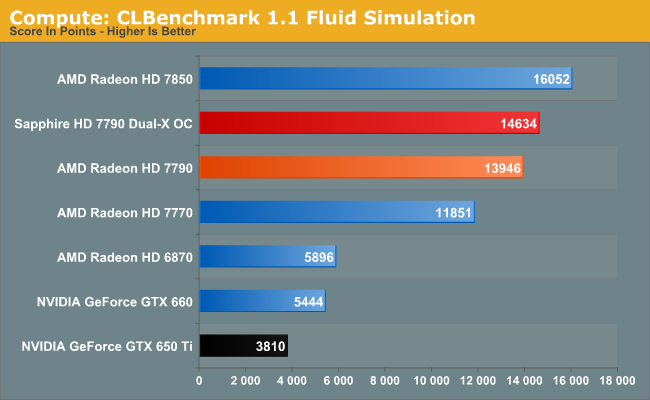
Moving on, our 4th compute benchmark is FAHBench, the official Folding @ Home benchmark. Folding @ Home is the popular Stanford-backed research and distributed computing initiative that has work distributed to millions of volunteer computers over the internet, each of which is responsible for a tiny slice of a protein folding simulation. FAHBench can test both single precision and double precision floating point performance, with single precision being the most useful metric for most consumer cards due to their low double precision performance. Each precision has two modes, explicit and implicit, the difference being whether water atoms are included in the simulation, which adds quite a bit of work and overhead. This is another OpenCL test, as Folding @ Home is moving exclusively OpenCL this year with FAHCore 17.
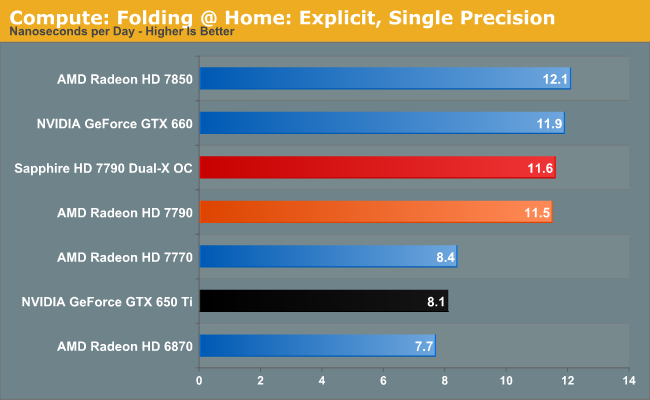
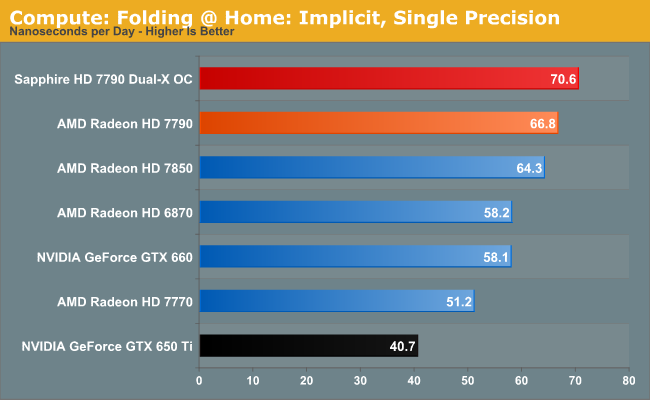
Our 5th compute benchmark is Sony Vegas Pro 12, an OpenGL and OpenCL video editing and authoring package. Vegas can use GPUs in a few different ways, the primary uses being to accelerate the video effects and compositing process itself, and in the video encoding step. With video encoding being increasingly offloaded to dedicated DSPs these days we’re focusing on the editing and compositing process, rendering to a low CPU overhead format (XDCAM EX). This specific test comes from Sony, and measures how long it takes to render a video.
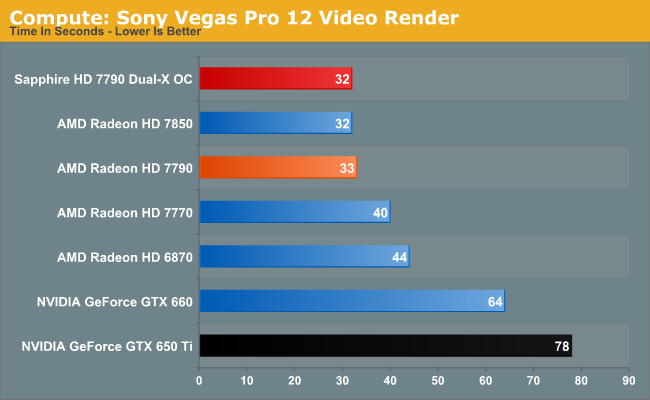
Wrapping things up, our final compute benchmark is an in-house project developed by our very own Dr. Ian Cutress. SystemCompute is our first C++ AMP benchmark, utilizing Microsoft’s simple C++ extensions to allow the easy use of GPU computing in C++ programs. SystemCompute in turn is a collection of benchmarks for several different fundamental compute algorithms, as described in this previous article, with the final score represented in points. DirectCompute is the compute backend for C++ AMP on Windows, so this forms our other DirectCompute test.
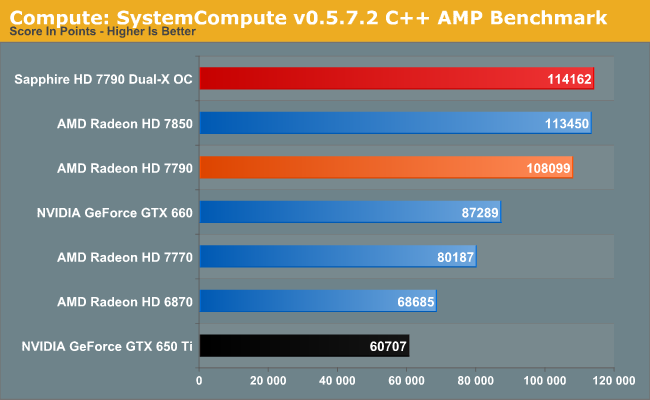


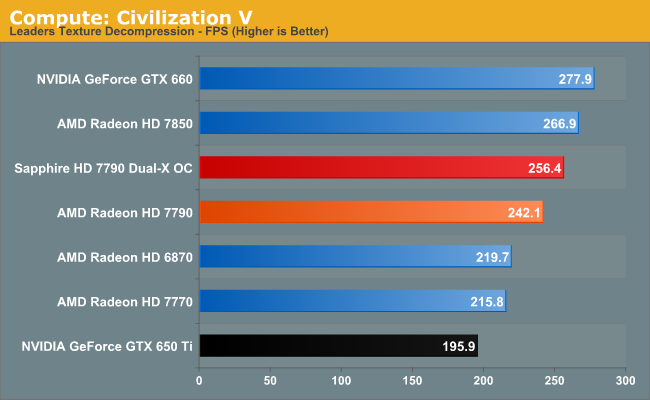








107 Comments
View All Comments
bebimbap - Friday, March 22, 2013 - link
would it be wrong of me to wait for the 7790 ghz ed?SithSolo1 - Friday, March 22, 2013 - link
There will be no GE of this card.Quote - "The Radeon HD 7790 runs at 1GHz, but is not going to be called a "GHz Edition" anymore. AMD feels that they have made the point about having 1GHz edition GPUs in the market in 2012, and did not feel a need to label this new one a GHz Edition. Therefore, it will just be known as Radeon HD 7790." - Brent @ HardOCP, Asus DCUII 7790 review
SithSolo1 - Friday, March 22, 2013 - link
Before someone gets confused, I'm not Brent. I just happened to read the review a bit ago and remembered that part about the Ghz Edition.Hardcore69 - Friday, March 22, 2013 - link
Don't see a point. As a PC gamer I want it all, not some laughably compromised card - just over 30FPS (if that) at 1080p with the settings turned up? What's the point, just buy a console. I'll stick with my 680.cyan1d3 - Friday, March 22, 2013 - link
While I agree with your sentiment, this card was not designed with us in mind, there is a large portion of people on budgets, who can't go ahead and blow ~$450 on a graphics card. There is also a large portion of people who see no need to play games at Ultra with high AA, etc.This card is a great line-up filler. I can see a use for this in a variety of budget gaming systems.
R3MF - Monday, March 25, 2013 - link
agreed.i spent £400 on an MSI 7970 Lightning, but not everyone is that stupid! :D
evonitzer - Friday, March 22, 2013 - link
Well with a name like Hardcore69, of course you would want the best of the best of the best (with honors). But I'm a casual PC gamer, so this card looks pretty great to me. My 4870 is getting a little (ok, very) long in the tooth. Why would I buy a console and pay full price for games, only use a controller, and have to pay a monthly fee (x360) just to play casually when I could pick up a $150 card and drop it into my computer?CeriseCogburn - Sunday, March 24, 2013 - link
His point wasn't your pathetic budget, his point was the graphics suck like a console.Just keep the 4870, it sucks too.
I am as mad as hell - Friday, March 22, 2013 - link
The day will come, in the not so distant future, that 700W PS requirements or higher for high-end gaming machines will come to an end (thankfully). And the whole system will not consume more than 100W and fits inside a mATX case or smaller (and no need for Godzilla size cooling fans anymore either).CeriseCogburn - Sunday, March 24, 2013 - link
It's called Haswell.